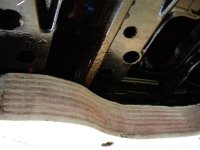I have used lifeseal and lifecaulk. Once installed you have to clean with acetone but try not to douse it.
LifeCaulk - "A long lasting, permanently flexible marine polysulfide sealant which can be sanded, painted, and used above and below the waterline. Tack-free in 1 to 3 days, excellent resistance to teak oils, gasoline, and diesel fuel. Ideal for teak decks, to bed deck and hull hardware, seal thru-hull fittings, and underwater seams. Will bond to fiberglass, rubber, metal, glass and itself. Cures to a firm flexible rubber seal with excellent waterproofing and adhesion qualities. Can be applied underwater for emergency repairs. Can be applied to damp surfaces."
LifeSeal - A unique combination of marine silicone and polyurethane, formulated especially for fiberglass. Life Seal® offers a fast-curing, low odor, high adhesion, non-sagging, non-corrosive, non-yellowing formula. It provides a durable permanent watertight seal for joints subject to structural movement. May be used above or below the waterline. Use for sealing decks to hulls, thru-hull fittings, vinyl ports, sealing/glazing windshields and bedding marine hardware. Will adhere to metal, glass, wood, Lexan®, ABS® and certain other materials. Can be removed without damaging gel-coat. Not recommended for ferro cement hulls, impregnated wood or oil-soaked materials. Cures in presence of water. Mildew resistant and acid-free. Custom colors available.

